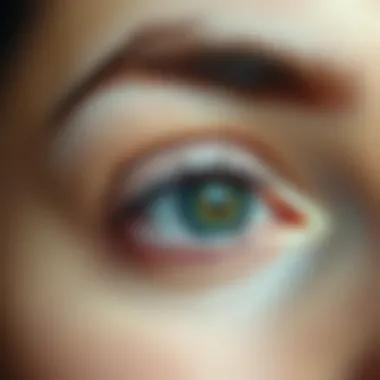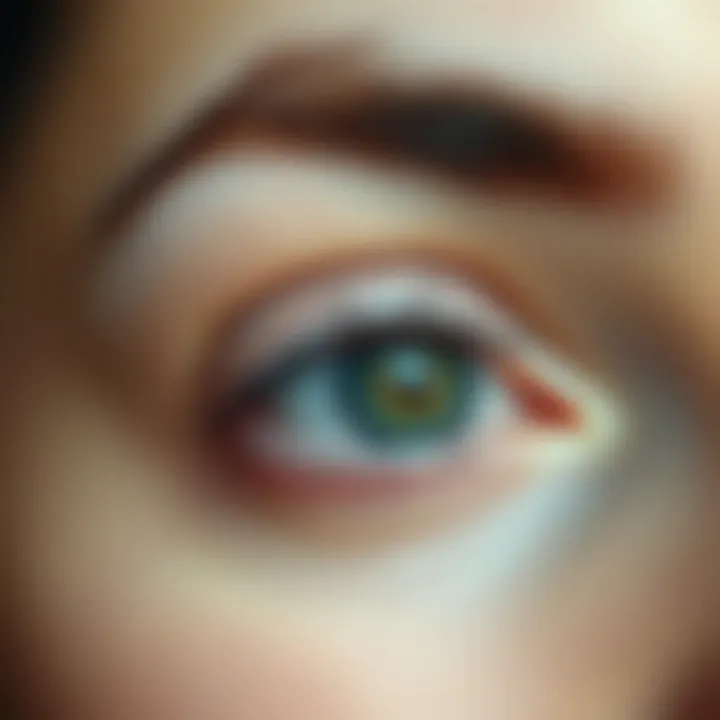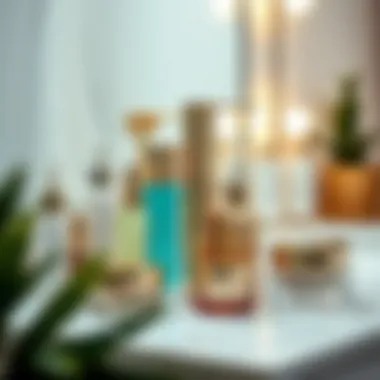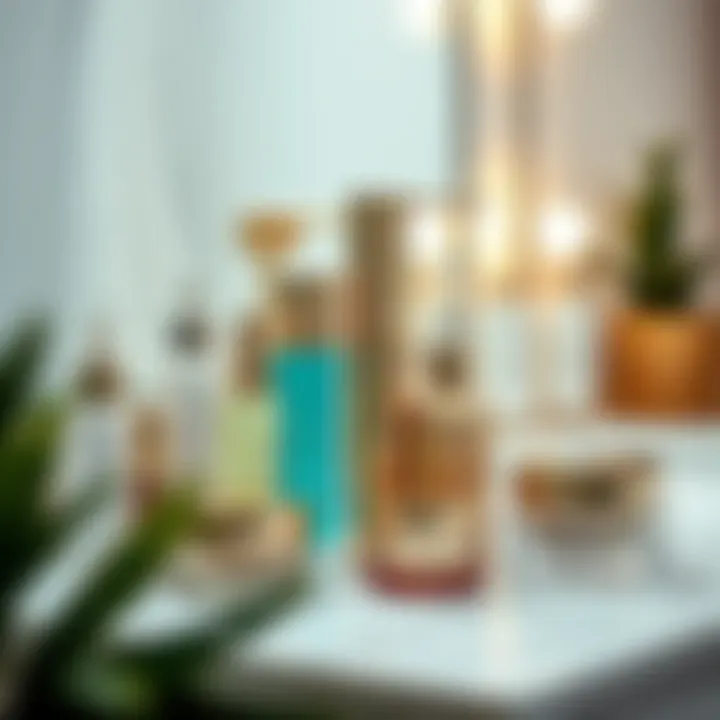Effective Strategies to Reduce Under-Eye Wrinkles


Intro
The skin around our eyes is notably thin and delicate, making it particularly susceptible to signs of aging. Under-eye wrinkles can appear earlier than one might expect, often due to a combination of environmental factors, genetics, and lifestyle choices. As we age, the collagen and elasticity of our skin diminish, leading to these unwanted lines. But fret not! There are various effective strategies to help diminish the look of wrinkles beneath the eyes.
In this piece, we will explore key trends in beauty, practical skincare routines, sustainable practices, and self-care techniques aimed at revitalizing the delicate area under our eyes. Whether you are looking to permanently eliminate those pesky lines or simply wish to enhance your overall appearance, there exists an array of options at your disposal.
Understanding what causes these wrinkles not only helps women develop tailored solutions but also empowers them to make conscious changes to their daily habits.
Key Trends
Overview of Current Aesthetic Trends
The aesthetic landscape is constantly shifting, and presently, there's a palpable focus on achieving a youthful and refreshed appearance. Women are increasingly gravitating toward products that promise hydration and subtle illumination. In fact, eye creams boasting cucumber extract, hyaluronic acid, and peptides are gaining traction, underscoring the importance of moisture in combating under-eye wrinkles.
Another emerging trend is the rise of minimally invasive procedures, such as light therapy and microneedling, which can stimulate collagen production while offering clients a non-surgical route to youthful skin. The beauty industry seems to embrace individualized approaches, encouraging women to select treatments that cater specifically to their skin type and concerns.
Popular Beauty Trends
Beauty trends today show a penchant for clean and natural products. The popularity of clean beauty brands highlights the demand for transparency in ingredient lists. Many women are opting for products that are free from synthetic additives, as they seek gentler options for their sensitive skin around the eyes.
Moreover, there’s been a considerable rise in DIY beauty routines. Tutorials abound on social media platforms for natural remedies like green tea bags and chilled spoons, which purportedly reduce puffiness and smooth out wrinkles. These methods not only invite creativity into skincare but also encourage women of all ages to experiment with what works best for them personally.
“Embracing individual needs in beauty routines is the key to effective skincare; what’s right for one may not suit another.”
Beauty Tips and Tutorials
Skincare Routines for Different Skin Types
Crafting a skincare routine that targets under-eye wrinkles necessitates an understanding of one’s skin type.
- For Dry Skin: Look for hydrating creams packed with ceramides and essences. Regularly applying oils enriched with vitamin E can also provide essential moisture.
- For Oily Skin: A lightweight gel-based eye cream can offer hydration without clogging pores. Ingredients like green tea extract can also help reduce inflammation.
- For Sensitive Skin: Opt for hypoallergenic creams free from fragrances and harsh chemicals. Products with chamomile or aloe vera may provide soothing benefits.
Step-by-Step Makeup Tutorials
Makeup can serve as a temporary solution for under-eye wrinkles. A light application of a smooth concealer can provide a youthful glow. Here’s a simple step-by-step:
- Start with a hydrating eye cream to provide a smooth base.
- Use a concealer that matches your foundation and apply a small amount on the under-eye area.
- Gently tap with your ring finger for even distribution; this finger applies the least pressure.
- Set it with a light, translucent powder to avoid creasing.
Sustainable Practices
Understanding Sustainable Beauty
Sustainable beauty practices encompass methods that prioritize environmental health and social responsibility. As the beauty industry moves toward a greener future, many companies are adopting eco-friendly packaging and sourcing natural ingredients ethically. Choosing sustainable brands for skincare can not only promote skin health but also contribute to a larger movement towards conservation.
Tips for Sustainable Beauty
To integrate sustainability into your beauty routine:
- Choose Natural Products: Seek out brands that utilize natural and sustainably sourced ingredients.
- Support Local Businesses: Local boutiques often provide products without excessive packaging and utilize local resources.
- Recycle: Properly recycle empty containers and opt for refillable products when available.
In essence, reducing under-eye wrinkles involves a multifaceted approach that draws on current trends, individualized care tips, and sustainable practices. By consciously choosing products and routines that resonate with one's unique needs and values, women can take significant strides towards healthier, more youthful skin.
Understanding Under-Eye Wrinkles
Under-eye wrinkles can be a source of frustration for many, particularly since the skin around the eyes is thinner and more delicate than other areas of the face. This section aims to shed light on these pesky lines that often signify the aging process and can lead to a tired or worn appearance. As we peel back the layers to understand these wrinkles, it's crucial to acknowledge the multifaceted elements at play.
What Causes Under-Eye Wrinkles?
Natural Aging Process
The natural aging process is a one-way street; we all age, and with it, the skin loses its youthful characteristics. As we tick off each birthday, collagen production tapers off, which is a fundamental protein responsible for skin strength and elasticity. This decrease in collagen is particularly noticeable around the eyes, where the skin can begin to sag and crease.
Notably, this aspect of aging is unavoidable, making it a prevalent choice for this article. The key characteristic to grasp here is that aging doesn't just cause wrinkles, it shapes how our skin appears over time. Its unique feature is how, unlike other skin issues, aging is a natural phase of life, albeit with certain disadvantages such as diminished elasticity and increased visibility of wrinkles.
Sun Exposure
Sun exposure is a double-edged sword; while some sunlight is necessary for vitamin D, prolonged exposure can lead to unwanted skin damage, including under-eye wrinkles. The UV rays from the sun break down collagen and elastin—two essential building blocks for healthy skin—which can create premature signs of aging.
It’s important to recognize the key characteristic of sun exposure: it is preventable. Using sunscreen is not just a seasonal activity but a year-round commitment. The unique aspect is that while you enjoy the warmth of the sun, you’re also at risk if proper precautions aren't taken. This discussion underscores the advantages of being proactive about sun safety in the fight against under-eye wrinkles.
Genetics and Heredity
Genetics and heredity have a significant hand in the game of aging. Certain skin types and characteristics are often passed down through generations, meaning that if your parents displayed wrinkles early on, you might too. This trait can affect the thickness of skin and how collagen is produced, leading to a distinct element of predictability in how aging will unfold.
A major benefit of recognizing the role of genetics is that it allows individuals to prepare and tailor their skincare and lifestyle choices according to what they might expect. However, the disadvantage here is that there are limits to what can be changed; genetics is not something one can control.
Poor Lifestyle Choices
Poor lifestyle choices encompass a variety of factors, from lack of sleep to diet and smoking. Consistently making bad choices leads to increased stress, which is often reflected in our skin. Whether it's dehydration from not drinking enough water or the oxidative stress from an unhealthy diet, these choices compound, leading to a less vibrant appearance.
This aspect is relevant as it offers a path to beneficial change. Small lifestyle modifications can have a monumental effect on how our skin ages. The unique feature of this category is its flexibility; unlike genetic factors, individuals can actively make better choices. However, the disadvantage is that changing habits often requires time and effort, which may deter many from making those necessary tweaks.
The Importance of Skin Structure
Understanding the structural elements of our skin is crucial in addressing under-eye wrinkles. Collagen, hydration, and the management of fat distribution all play significant roles in maintaining an appearance that many aspire to have.
Collagen and Elasticity
Collagen serves as the backbone of youthful skin. Its presence provides structure, helping the skin to bounce back when stretched or pulled. As we age, collagen decreases, which directly contributes to the appearance of lines and sagging skin.
In this article, grasping the importance of collagen and elasticity invites readers to consider how maintaining these elements can influence their skincare decisions. The unique feature of collagen is that while its production decreases with age, various products can help stimulate its production, giving a path for improvement. However, the disadvantage of relying on skincare is that results may vary significantly among individuals.


Hydration's Role
Hydration plays a pivotal role, not only for overall health but specifically for skin health. Dehydrated skin often appears dull and can accentuate lines, particularly in delicate areas like under the eyes. Keeping skin well-hydrated can create a plump appearance, which somewhat smooths out the visibility of wrinkles.
The key characteristic here is the direct link between moisture content and skin health, making hydration a non-negotiable aspect of skincare. The unique feature of hydration is its ease; drinking water is simple compared to invasive treatments. Yet, the disadvantage is that topicals can't replace the fundamental need for internal hydration—what works for one may not suffice for another.
Fat Redistribution
As time marches on, our body undergoes various changes, including fat redistribution. Fat in the face can shift, often leading to a hollowed look under the eyes. This shift may deepen existing lines, making them more pronounced.
Understanding fat redistribution is vital because it highlights how structural changes can affect the visibility of wrinkles. The key characteristic here is how age brings about a natural migration of fat deposits in the face. Such unique features may offer insight into why some may choose fillers or other volumizing treatments to address the loss of fullness. However, the disadvantage is that adding volume can sometimes produce an unnatural appearance if not done carefully.
In summary, comprehending the nature of under-eye wrinkles involves recognizing diverse factors that contribute to their formation. By outlining causes and underlying skin structures, women can take informed steps towards reducing the appearance of these wrinkles, tailoring their approach to skincare and lifestyle choices.
Skincare Regimens for Wrinkle Reduction
Taking care of the skin around the eyes is critical because this area is particularly delicate and prone to showing signs of aging. Establishing a solid skincare regimen plays a significant role in minimizing the appearance of under-eye wrinkles. A thoughtful routine not only addresses existing wrinkles but can also prevent new ones from forming.
A comprehensive skincare routine is like a well-orchestrated symphony—it requires the right elements to create harmony. Specific ingredients and methods can significantly influence overall skin health. Understanding these key aspects offers clarity on how to tailor a regimen that works effectively for you.
Key Ingredients to Look For
Retinol
Retinol is often hailed as a powerhouse in anti-aging skincare. It works by promoting cell turnover and stimulating collagen production, which can effectively smooth out fine lines and enhance skin texture. One of the most appealing qualities of retinol lies in its versatility; it can be used by various skin types. However, it may cause irritation for those with sensitive skin, making gradual introduction a wise choice. Using retinol in moderation can yield impressive results without overwhelming the skin.
Peptides
Peptides serve as building blocks for proteins such as collagen and elastin, both of which are crucial for maintaining youthful skin. These small chains of amino acids signal the skin to produce more collagen, thereby enhancing elasticity and firmness over time. Their specialized function makes them a smart addition to any anti-aging routine. As a gentle yet effective option, peptides do not typically cause adverse side effects, making them suitable for a wide range of skin types, including sensitive ones.
Hyaluronic Acid
Hyaluronic acid is known for its remarkable ability to hold moisture—up to 1,000 times its weight! This hydration is vital for plump and youthful skin, especially in the under-eye region, which often shows dryness. Integrating hyaluronic acid into a skincare routine can result in a smoother and more hydrated appearance. While generally safe for most people, overuse in a humid climate may lead to an uncomfortably sticky feeling on the skin.
Vitamin
Vitamin C is a potent antioxidant that combats free radicals, which contribute to skin aging. This vitamin brightens the skin, reduces pigmentation, and improves overall texture. Its ability to enhance collagen synthesis adds another layer of benefit for reducing wrinkles. However, vitamin C can be unstable when exposed to air and light, which makes proper storage essential to maintaining its efficacy.
Building a Nighttime Routine
A well-structured nighttime skincare routine is vital for achieving long-term results. The skin is particularly receptive to treatments while you sleep, making this an opportune time for effective product application.
Importance of Consistency
Consistency is key when it comes to skincare. Regular application of targeted products amplifies their effectiveness over time. Establishing a nightly routine creates a sense of commitment to skin health, leading to improved outcomes. It’s essential to approach skincare with the mindset that positive results don’t happen overnight; patience can be immensely rewarding.
Layering Products
Proper layering of skincare products is another secret weapon in fighting under-eye wrinkles. The order of application matters greatly—thinner products should be applied before thicker ones. For example, starting with a serum and then sealing in moisture with a cream can enhance effectiveness. Knowing the best way to layer products can be a game changer for your skin.
Specialized Eye Creams
Using specialized eye creams can target specific concerns like puffiness and fine lines. These formulations are often richer in texture and contain ingredients uniquely suited for the sensitive skin around the eyes. Choosing the right eye cream, however, can be tricky as formulations vary widely. A well-chosen cream can significantly contribute to a more youthful appearance, while a poor choice may yield little to no results.
Lifestyle Changes to Combat Wrinkles
Under-eye wrinkles can be an inevitable part of the aging process, but adopting certain lifestyle changes can significantly combat their appearance. These modifications not only enhance skin health but also contribute to an overall sense of well-being. From dietary choices to sleep quality, the factors influencing skin elasticity and moisture levels are intertwined with our daily habits. It's essential to recognize how our routines govern the skin's ability to recover and regenerate.
Diet and Nutrition
Nutrition plays a critical role in maintaining skin health. What you feed your body mirrors how your skin looks. Beyond the obvious benefits, a balanced diet can help in reducing the appearance of those pesky wrinkles.
Antioxidant-rich Foods
Antioxidant-rich foods, such as berries, nuts and green leafy vegetables, are known to combat oxidative stress caused by free radicals. These foods are powerhouses of vitamins and minerals that help preserve skin's youthful look. Their primary feature lies in their ability to neutralize harmful effects of environmental pollutants and UV rays. Including a variety of these foods in your diet not only nourishes the skin but also supports overall health. One potential downside is that some may find it challenging to diversify their diets, leading to monotony in meals. However, the benefits clearly outweigh the inconvenience.
Hydration Strategies
Proper hydration is essential for maintaining skin's elasticity and plumpness. Drinking enough water throughout the day is a must, but other strategies can enhance hydration too. Herbal teas or water-rich fruits like watermelon can contribute significantly to fluid intake. The main advantage of proper hydration is the visible reduction in the appearance of fine lines and wrinkles. A downside here might be frequent trips to the restroom—still, keeping your skin supple is worth the effort.
Avoiding Processed Sugars
Processed sugars can wreak havoc on skin structure, promoting inflammation and collagen degradation. By reducing or eliminating these from one's diet, the skin has a better chance to maintain its firmness and elasticity. A key characteristic of avoiding processed sugars is the reduction of glycation, a process that occurs when excess sugar molecules bond with proteins, damaging collagen. This approach is relatively simple to implement, but many face cravings or addictions to sweet foods. Focused alternatives, like organic fruits or honey, can provide a healthier sweet fix without the damage.
The Role of Sleep
Sleep is another cornerstone of skin health and wrinkle reduction. Quality sleep fosters cellular repair and regeneration, which is especially beneficial for the delicate skin under the eyes.
Impact of Sleep Quality
Not just the quantity, but the quality of sleep can make a world of difference. Deep sleep cycles are crucial for the body to heal and rejuvenate, which extends to skin health as well. When we don’t sleep well, it reflects visibly on our skin. Dark circles and wrinkles become more pronounced. As a notable benefit, enhancing sleep quality can also improve mood and cognitive function—talk about a two-for-one! Maintaining a regular sleep schedule can help, but it requires self-discipline and consistency.
Sleeping Positions
The position in which we sleep can also influence wrinkle formation. For example, individuals who sleep on their stomach or side may notice more creasing around the eyes over time. Back sleepers may have a slight advantage in reducing these lines, as the weight of the face doesn’t press against the pillow. Adjusting sleeping patterns can be difficult, though, especially for those accustomed to certain positions. Nonetheless, it’s worth considering for wrinkles' sake.
Restorative Practices
Implementing restorative practices into your daily routine can significantly enhance skin health. Techniques like yoga or meditation help reduce stress, which is often linked to premature aging. Additionally, practices promoting relaxation can result in better sleep quality. Some might find these practices to be time-consuming, but even just a few minutes daily can be quite impactful for maintaining skin's resilience and youthfulness.
In summary, adopting these lifestyle changes can lead to healthier skin and, in turn, fewer under-eye wrinkles. By being mindful of what we consume, how we hydrate, our sleep habits and how we manage stress, we can take substantial strides in the quest for smoother skin.
Non-Invasive Treatments for Under-Eye Wrinkles


The quest to minimize the appearance of under-eye wrinkles often leads individuals to consider various under-the-radar options. Non-invasive treatments are becoming increasingly popular due to their effectiveness and lower risk compared to more invasive procedures. In this section, we will explore two primary non-invasive methods: dermal fillers and chemical peels. These options can provide substantial enhancement without the need for surgical intervention, making them appealing for a wide demographic.
Dermal Fillers
How They Work
Dermal fillers have gained traction for their ability to plump up the skin, significantly reducing the appearance of fine lines and wrinkles. They mainly work by injecting substances like hyaluronic acid into targeted areas. This compound, naturally found in the body, attracts moisture, providing a currently visible fullness under the eyes. The key characteristic here is the immediate result that fillers offer, which is why many consider them a beneficial choice. However, one must keep in mind that the effects are temporary and typically last from several months to a year. A unique advantage of fillers is that they can also stimulate collagen production over time, contributing to longer-term benefits.
Potential Risks
While dermal fillers are generally safe, it’s crucial to highlight potential risks. Common risks include bruising, swelling, or uneven results. These side effects can vary based on individual skin sensitivity and the practitioner’s skill. Awareness of these elements is important before committing to the procedure. Some individuals may experience allergic reactions, although they’re rare. It’s always best to consult with a qualified professional to weigh the risks against the desired outcome, ensuring an educated decision.
Expected Results
The results from dermal fillers can be quite satisfying for many. Most users notice a reduction in under-eye wrinkles almost immediately after the treatment. The plumpness can significantly rejuvenate one’s appearance, leading to a more youthful look. An important feature of the results lies in their versatility; different formulas can be tailored to meet individual needs. However, as fillers are not permanent, maintaining the results involves follow-up treatments. Overall, fillers are widely regarded for their quick recovery time and dramatic results, but it’s essential to align expectations with the subsequent need for maintenance.
Chemical Peels
Types of Peels
Chemical peels present an effective avenue for reducing under-eye wrinkles through controlled exfoliation. There are three main types: superficial, medium, and deep. Superficial peels use mild acids that only penetrate the outer layer of skin, making them ideal for minor issues like dryness or uneven texture. Medium peels reach into the middle layer, suitable for more pronounced wrinkles. Deep peels offer the most intense exfoliation, targeting deeper lines but require a longer recovery period. Each type of peel serves a distinct purpose in wrinkle reduction, making it vital to select the one that aligns with individual skin concerns.
Recovery Process
The recovery process post-chemical peel varies based on the type. For superficial peels, recovery is usually quick with minimal redness, allowing a return to daily activities almost immediately. However, medium and deep peels have longer downtime, as they might necessitate days to weeks of healing. Skin may appear red or flaky, which is a crucial factor to consider before opting for this treatment. Overall, understanding the recovery timeline helps in planning post-treatment care and managing expectations effectively.
Long-Term Effects
Chemical peels can have lasting effects on the skin if integrated into a regular skincare regimen. Regular treatments can lead to smoother skin texture and reduced wrinkles over time. The initial results may leave the skin more luminous and youthful while gradually improving overall skin health. However, individuals must note that factors like sun exposure can impact the longevity of these effects. Thus, adopting sun protection measures becomes essential post-treatment to maintain the benefits achieved.
In summary, non-invasive treatments like dermal fillers and chemical peels offer effective strategies for tackling under-eye wrinkles. Each method balances results with potential risks, so a thorough understanding is vital.
Choosing the right one often depends on individual preferences, desired outcomes, and skin conditions. Consulting professionals who specialize in these treatments will help in navigating the options available, ensuring a tailored approach to enhancing one's appearance.
Professional Procedures for Enhanced Results
When it comes to addressing under-eye wrinkles, some individuals may find that their daily skincare routines and lifestyle changes aren't quite cutting it. In such cases, professional procedures offer advanced solutions that can lead to more noticeable and lasting improvements. These procedures include options like laser treatments and microneedling, both of which can significantly enhance skin texture and appearance.
What makes these professional interventions appealing is not just their efficacy but also the tailored approach they provide. Professionals can assess individual skin types and concerns, enabling them to recommend specific treatments suited to each case. Hence, these procedures not only aim to reduce wrinkles but also enhance the overall facial aesthetics.
Laser Treatments
Laser treatments have gained popularity in recent years as a method for rejuvenating the under-eye area. By targeting specific layers of skin with concentrated light energy, they promote collagen production and skin tightening, thereby reducing the appearance of wrinkles.
Fractional Laser Resurfacing
Fractional laser resurfacing is among the most advanced laser treatment options available. This technique focuses on creating controlled micro-injuries to the skin, which stimulates the body's natural healing processes. As a result, new collagen forms, which rejuvenates the skin and effectively reduces wrinkles beneath the eyes. One key characteristic of this method is its ability to treat only a fraction of the skin at a time, which minimizes downtime while maximizing results.
Advantages of fractional laser resurfacing include:
- Significant improvement in skin texture
- Quick recovery time
- Long-lasting results when combined with proper skin care
However, potential disadvantages may include:
- Risk of temporary redness or swelling
- Need for multiple sessions to achieve optimal results
Benefits and Considerations
When considering laser treatments, it's essential to weigh the benefits against the possible downsides. The key benefit of these treatments is the promotion of new collagen, which is vital for healthy skin. They can lead to smoother skin texture and reduced fine lines. However, this sophisticated approach requires careful consideration of factors like skin type, sensitivity, and pre-existing conditions.
Considerations include:
- A consultation with a qualified dermatologist
- Cost implications and potential side effects
- Realistic expectations regarding the results
Post-Treatment Care
Post-treatment care is crucial for ensuring the best possible outcome after any laser procedure. It usually includes avoiding direct sun exposure, using gentle cleansers, and applying soothing creams to allow for optimal healing. This detail can't be understated as proper care directly impacts the longevity of the results.
Key points about post-treatment care include:
- Hydration of the treated area is essential
- Use of sun protection to avoid pigmentation issues
- Following the dermatologist's aftercare instructions
Microneedling
Microneedling has emerged as a popular choice for those seeking to rejuvenate their under-eye area through a more natural method. This process involves the use of fine needles to create tiny punctures in the skin, promoting collagen and helping in skin renewal.
Understanding the Process
The process of microneedling is relatively straightforward. A healthcare professional will use a device equipped with tiny needles to create controlled micro-injuries in the skin. This action spurs the skin's natural healing response and boosts collagen production, leading to improved skin elasticity. Its primary advantage is its non-invasive nature, meaning there’s generally a reduced risk involved in the procedure.
Strengths of microneedling include:
- Minimal downtime compared to deeper treatments
- Versatile application for various skin types
- Can be combined with serums for enhanced effects
Yet there are considerations to keep in mind:
- Temporary redness or sensitivity post-treatment
- May require more than one session for results to be visible
Sessions Required
Microneedling generally requires multiple sessions for optimal results. Typically, a series of three to six sessions spaced a few weeks apart is recommended to achieve the desired effect. Each session builds upon the previous, gradually enhancing the skin's texture and tone in the under-eye region.
Ultimately, the number of sessions needed is influenced by skin condition and individual goals. Therefore, it's crucial to have a discussion with a practitioner beforehand to set realistic expectations.


Results Timeline
As with most cosmetic procedures, seeing results from microneedling is not instantaneous. It usually takes a few weeks to notice visible improvements as collagen forms naturally in the skin. However, many individuals report feeling their skin becoming smoother and firmer even before the full effects become apparent.
This gradual process aligns well with natural skin rejuvenation, making microneedling a sustainable option for those aiming to combat wrinkles under the eyes. Patience is key, as the results can continue to improve for several months following the last treatment.
Natural Remedies and Their Efficacy
Natural remedies provide a holistic approach to tackling under-eye wrinkles, appealing to those who prefer to explore gentler, more organic solutions. These methods often draw on decades of tradition and the potent qualities found in nature. By implementing natural remedies, individuals can not only diminish the appearance of wrinkles but also nourish the skin and promote overall well-being.
Home Remedies
Effective Ingredients
When it comes to tackling under-eye wrinkles, certain natural ingredients stand out for their effectiveness. Aloe vera, for instance, is lauded for its hydrating properties. It's rich in vitamins, antioxidants, and enzymes, which can combat dryness and improve skin elasticity. Coconut oil is another gem, known for its deep moisturizing abilities. This ingredient locks in moisture and can help in smoothing out fine lines. Both ingredients shine due to their gentle nature, making them safe for most skin types.
However, one must be cautious. While natural, some may have skin sensitivities or allergies to these ingredients. Therefore, it’s wise to perform a patch test before fully integrating any new component into your skincare routine.
Application Techniques
How you apply these natural remedies can significantly affect their performance. For example, gently massaging aloe vera or coconut oil into the skin helps stimulate blood circulation, enhancing absorption. Using your ring finger for application can ensure a light touch, ideal for the delicate eye area.
It's also crucial to employ consistent techniques: a gentle patting motion rather than rubbing can be more effective. Despite their holistic benefits, some users might find these methods slow to show results. Patience is key; adopting a dedicated routine often yields the best outcomes over time.
Frequency of Use
Consistency is the backbone of effectiveness. Using natural remedies daily can create a more significant impact than sporadic application. A common recommendation is to apply ingredients like aloe vera in the evening and let them work overnight.
While it may not provide instant results, adopting a regular regimen can yield improvements in skin texture and appearance over weeks. One potential downside is the belief that natural solutions take longer to work. Yet, in many cases, the longer-lasting effects of these methods might outweigh the appeal of quicker results from harsher treatments.
Herbal Solutions
Chamomile and Its Properties
Chamomile is often hailed for its calming and anti-inflammatory effects. In the realm of skincare, it helps soothe and reduce puffiness around the eyes. Chamomile contains antioxidants that can protect against skin damage and promote skin healing, making it a fantastic ally against wrinkles.
However, it’s essential to note that some individuals might have allergic reactions to chamomile, particularly those with sensitivities to other plants in the Asteraceae family. This strong characteristic of chamomile can be beneficial, but understanding your body’s response is crucial before using it widely.
Green Tea Benefits
Green tea takes the stage as another potent herbal solution. With a high concentration of antioxidants called catechins, it provides protective benefits for the skin. Its anti-inflammatory properties can soothe irritated skin and reduce the appearance of fine lines. Many prefer incorporating it into their skincare routine, with options ranging from topical creams to brewed compresses for the under-eye area.
While the advantages seem promising, it’s worth noting that not all green tea products are created equal. Some might lack the active compounds needed for optimal effect, highlighting the importance of choosing high-quality sources.
Other Herbal Options
A broad array of herbs, like lavender or ginseng, presents additional options for wrinkle treatment. Each offers unique properties, from ginseng’s rejuvenating effects to lavender’s soothing capabilities. Moreover, these options celebrate versatility, as they can be blended into homemade masks or used in tea form for added skin benefits from within.
Nonetheless, users should be vigilant about sourcing herbs from reputable suppliers, as potency and quality can vary significantly. Finding balance among these diverse herbal options allows individuals to customize their approach based on skin type and preferences.
Effective natural remedies deserve a proper place in the skincare conversation, providing safe and nourishing alternatives to commercial products.
Maintaining Results and Long-term Care
Keeping under-eye wrinkles at bay isn’t just about the initial treatments or products you use; it’s also about maintaining the results over the long haul. This section focuses on essential strategies to ensure your efforts translate into enduring outcomes. A consistent approach to skincare, mindful living, and regular evaluations can drastically impact how you manage and diminish those fine lines. Investing time in these practices pays off in the appearance and health of your skin.
Regular Skin Assessments
Importance of Monitoring Changes
Monitoring the skin's condition is key. It allows you to observe any improvements or new concerns. This can be especially true for the delicate area under the eyes where changes might happen swiftly. Regular assessments help identify what’s working and what isn’t. With the constant shift in our skin’s needs due to factors like seasons and stress levels, tracking these changes ensures that you don’t miss any early signs of trouble or inflammation.
What makes regular assessments beneficial is that they prevent the situation from worsening unnoticed. It’s a proactive step, rather than reactive. However, it can sometimes feel tedious but keeping a skincare journal can make it easier.
Adjusting Routines Accordingly
Once you have established a routine for monitoring your under-eye area, knowing how to adjust it is equally important. Whether it’s changing your moisturizer or adding a new product, flexibility is essential to nail the balance between hydration and treatment.
The beauty of adjusting your routine lies in tailoring it to your unique skin's needs. You might find that some days call for more intensive hydration while others might focus on rejuvenating ingredients. This adaptability can empower you, helping you respond effectively to the skin's evolving state.
Consulting Professionals
When in doubt, seeking advice from professionals can be a game changer. This can include dermatologists and skincare specialists who can give insights tailored to your needs. They can evaluate your skin more accurately and provide recommendations that might not be evident to the untrained eye.
The standout feature about consulting professionals is their expertise. They are well-versed with the latest technologies and treatments that could illuminate your path to healthier skin, which brings peace of mind. That said, consulting can come with costs and isn't always necessary for every minor issue. Finding the right rhythm between professional insights and personal monitoring is crucial.
Integrating New Products Wisely
Patch Testing New Ingredients
When adding new skin products, patch testing is essential. This method determines how your skin reacts before applying a new product widely. Applying a small amount on a less conspicuous area helps identify possible allergic reactions or irritations.
This technique is smart, as it can save a lot of hassle down the line. A notable advantage is that it encourages mindfulness in your routine by ensuring every addition is a fit for your skin. The downside, though, is that it might require patience, as testing can extend the timeline before new products are fully integrated.
Layering Techniques
Layering products is an art that requires patience and thoughtfulness. Understanding how to layer serums, creams, and treatments allows for maximum absorption and effectiveness of each product used.
A key highlight of layering is its potential to enhance hydration and treatment penetration. Using the correct order—starting from the thinnest to thickest consistency—ensures each product can do its job. However, caution is needed: using too many products at once can overwhelm the skin, leading to irritation instead of improvement.
Gradual Preambles
Introductions of new products should be gradual. This gives your skin a chance to acclimatize to new ingredients without overwhelming it. Skipping to using a multitude of new products at once can lead to adverse reactions or just a muddled understanding of what’s effective.
The strength of gradual introductions lies in their ability to provide clarity regarding each product's effects. It’s like introducing new flavors in your diet; you’ll know what you like and what doesn’t sit well with you. However, patience is key, as it could delay some desired results.
A well-rounded approach to maintaining results not only keeps under-eye wrinkles in check but also helps promote overall skin health.
In summary, maintaining results and caring for your skin doesn’t have to be a complex process. With regular assessments, adaptability in routines, professional assistance, and smart product integration, you can craft a skincare strategy that’s effective and sustainable.



